There’s nothing quite so mystical as a crisp, heavy-dewed, humid, 73-degree morning at first light. The fences, shrubs, trees and anything that didn’t move during the night are shrouded in artfully constructed spider webs that glint and dazzle in the rays of the rising sun.
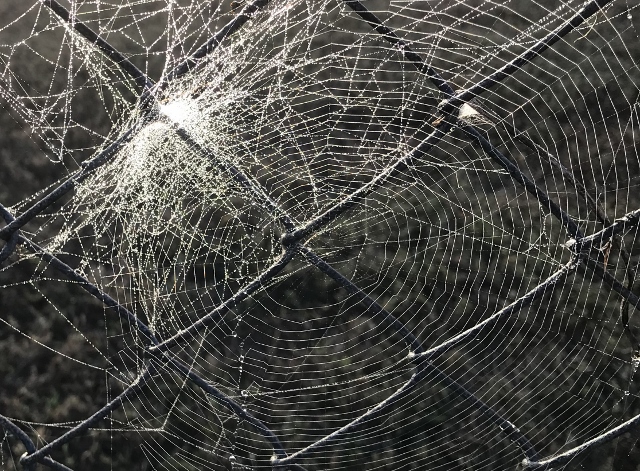
Conversely, there’s nothing so annoying as walking face first into an invisible mask of clingy, stringy, sticky spider web filaments, especially when you suspect the homeowner has escaped the eruption and is now probably in your hair.
There are two kinds of spiders, in a most general sense, based on their hunting styles: those that trap and those that hunt. There are 45,000 known species of spiders worldwide. Likely, there are more than a thousand species within Texas and most of those can be found in South Texas, according to Texas A&M University’s Department of Entomology.
Spider species are called arachnids because they belong to the class of animals called Arachnida. Spiders are not insects. Spiders have two body parts, eight legs and no antennae. Most spiders have eight eyes; some as many as 12. Spiders are invertebrates; they don’t have bones; they have an exoskeleton.
It’s the trappers that build the webs, and those web masters are considered garden spiders — that’s with a lower case “g” — and in a generic sense, those spiders that are most prevalent in the garden. However, there is a spider with the name garden spider (Argiope aurantia) that is often seen in Valley gardens and also called the yellow garden spider or the yellow-and-black garden spider. All garden spiders(Argiope aurantia) are orb weavers, but all orb weavers are not the yellow-and-black garden spiders.

I want to point out that there are two spiders that are dangerous both here in the Valley and elsewhere. They are the black widow and the brown recluse. This article is not about those two spiders. The following link has excellent information about them if you need a refresher: https://sciencing.com/what-poisonous-spider-humans-4586114.html
This article is about orb weavers because they are fun and interesting and appear in a wide range of startling colors, shapes and sizes. Their markings vary from stripes, blotches and circles; some are even tattooed with shapes reminiscent of Art Deco design. Orb weavers come in a palette of colors from creamy white, lime green and chocolate brown to primary colors of red, green and yellow. Some are triangular in shape with humps, bumps, spikes and angles; others have distended rounded abdomens that seem to have been inflated like a balloon.
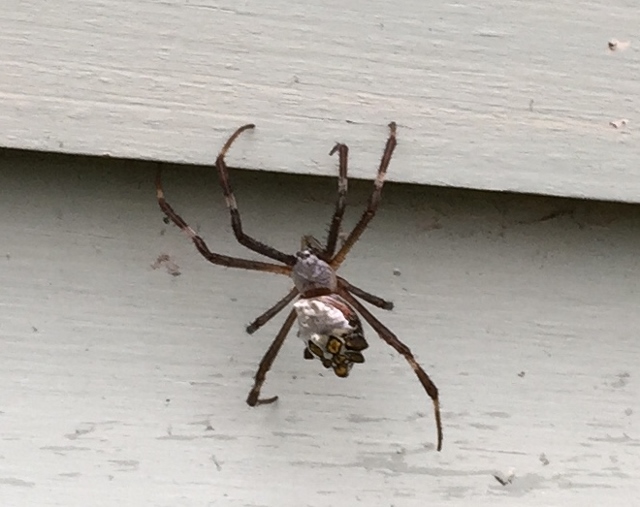
Orb weavers are members of the spider family Araneidae. More than 3,500 species of orb weavers have been identified throughout the world, and nearly 200 species are found in North America.
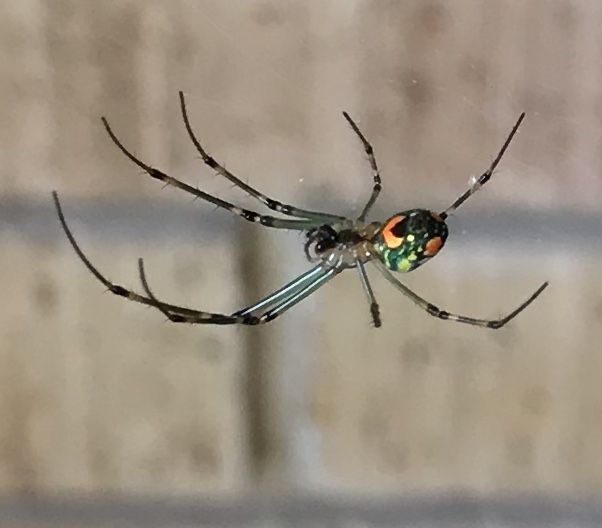
Spiders are important to the balance of nature. Just how important is quite amazing. Not only do they help maintain the world’s insects at a reasonable number, they are beneficial because they catch and eat insects, including crop-destroying insects in the field. Orb weavers eat twice their weight a day in aphids, ants, leafhoppers, leaf miners, grasshoppers, flies, beetles, moths, caterpillars, mosquitoes and wasps as well as other flying insects.
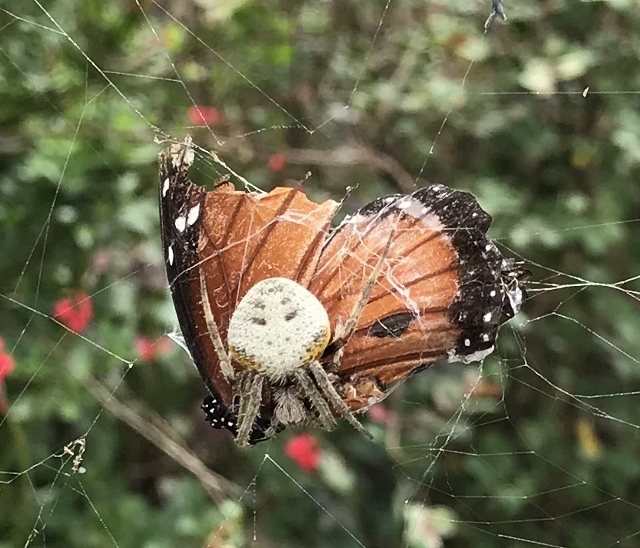
Yes, they aren’t discerning. They eat both bad and good insects — anything considered meat that gets trapped in their web. In the past, I’ve been known to disrupt a well-constructed spider web to free a dragonfly, butterfly or moth, if found in time, but the more I learn about the spiders in my garden the more I have a healthy respect for them and try to live amongst them without destroying their webs. Interestingly, orb weavers are creatures of habit. More probably, they are territorial and they don’t have an expanded roaming range. They basically stay in one spot and are consistent in rebuilding their webs in that same place. I try to remember where their usual spots are so I don’t plow into them in the early morning.
Most webs are gone by mid-morning. Orb weavers, when they take apart a web, eat the silk threads. The silk, which is made of protein, is recycled in the spider’s digestive system and goes to the silk glands where it replenishes the protein in order for the spider to make a new web.
It seems to me that November is for the spiders — apparently there’s something in that observation. One theory is that in the fall, during those longer nights, the spider has more time to build a larger web. Lights, like security lights, and even bright moonlight attract insects; where there are insects, there are spiders.
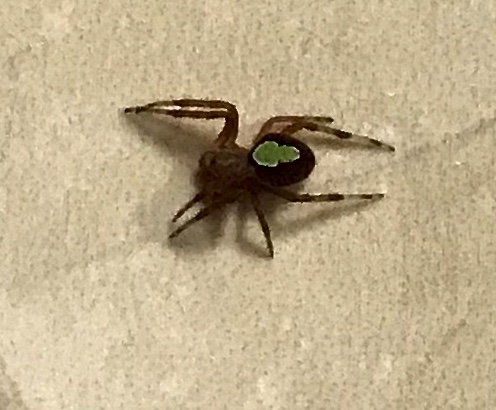
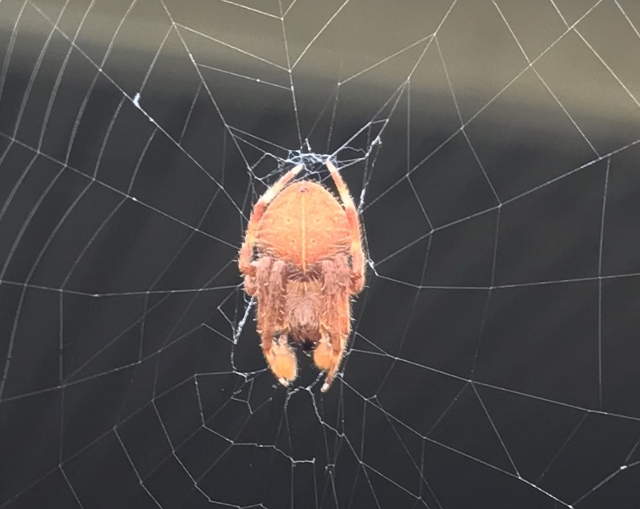
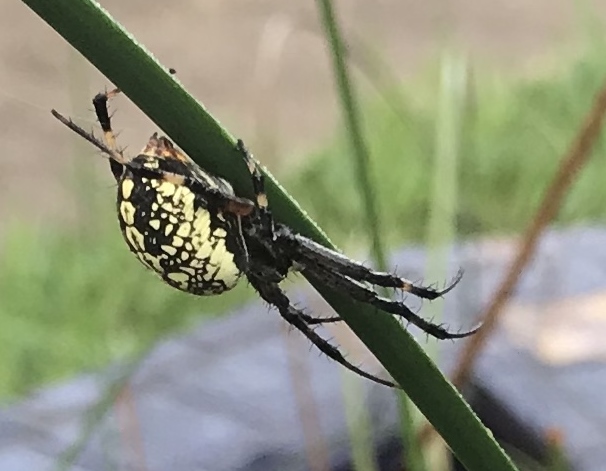
The wind has a play in spider web-making activity, too. Those nights with only a gentle breeze show more web-building activity. Something else to consider, spiders hatch in the spring and grow through the summer and by fall are bigger and more noticeable. Primarily though, fall is when garden spiders are laying their last clutch of eggs. Both male and female spiders most likely die soon after mating. Those last-clutch eggs will hatch within a couple of weeks but remain inside the egg sac until warmer weather returns in early spring.

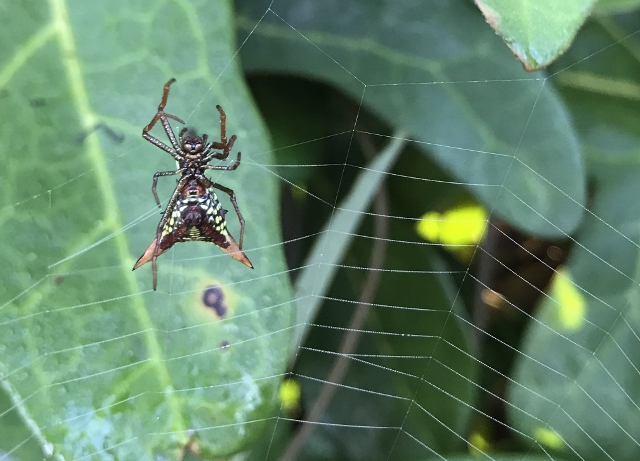
Orb weavers are docile, non-aggressive and usually flee at the first hint of danger, such as an iPhone being raised within a foot of the spider. Typically, the spider will run to the outer edge of its web and drop off. Orb weavers are not dangerous to people or pets and rarely venture inside human dwellings unless accidently on a potted plant.

These spiders-of-the-garden are completely harmless unless you’re an insect. Once an insect is trapped in the web, the spider will bite the prey, wrap it in silk, wait for it to die and then begin to eat. https://www.wildlifeheritage.org/orb-weaver-spider/ describes the activity in vivid detail: “As a first step in eating, the spider will literally vomit digestive fluid over the prey. Then the prey is chewed with the “jaws” (chelicerae), and the fluid is sucked back into the mouth together with some liquefied “meat” from the prey. The spider repeats this process as often as necessary to digest, and ingest, all but the inedible hard parts. What is discarded afterwards is a small ball of residue.”
Many references call the orb weaver’s web an engineering feat. They will spin their web anywhere they can find attachment points. The terms web and silk are used almost interchangeably, and generally, silk refers to single strands, while the term web refers to the constructed aggregate that is used to capture prey.
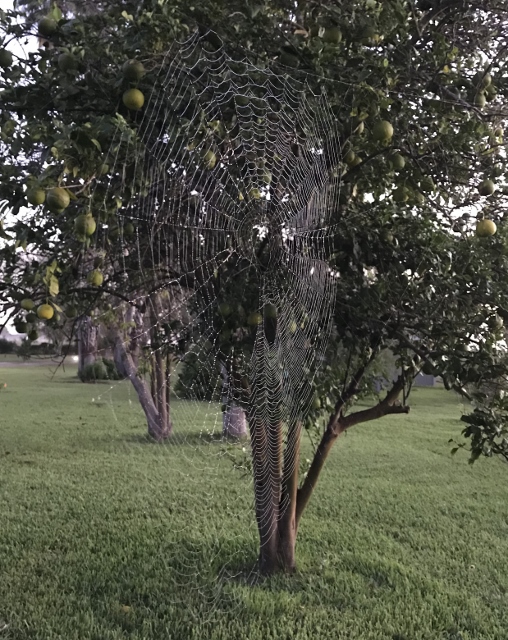
The orb weaver’s web consists of concentric circles with spokes radiating from the center to the anchor points. The web is begun when the spider floats a line of silk on the wind to another surface thereby establishing a bridge. The spider then uses its own weight and the elastic properties of the silk to establish an initial silk triangle. “The rest of the scaffolding,” according to Wikipedia, “follows with many radii of non-sticky silk being constructed before a final spiral of sticky capture silk.” The yellow garden spider, Argiope aurantia, also spins a thick zig-zag pattern in its web and may eat and re-spin its web each night.
Three other categories of spiders you might find in your Valley garden:
Jumping spiders leap to capture prey on plants
Wolf spiders run on the ground to catch prey at the base of plants
Crab spiders hide in flower blooms and ambush their prey
Cursorial spiders (those that run or scurry) such as jumping spiders, wolf spiders, and crab spiders, are especially important to gardeners because they move around the garden to find their prey. “Numerous studies have shown that spiders consume a massive amount of garden pests, including aphids, mites, asparagus beetles, squash bugs, budworms, caterpillars, and many more. Much of this predation takes place at night, when the watchful eye of the gardener is sound asleep,” according to information on this site: https://savvygardening.com/garden-spider/.
Other interesting reading that helped in researching spiders and orb weavers are at the following websites:
https://www.nwf.org/Educational-Resources/Wildlife-Guide/
Another great story. I’d had no idea orb weavers ‘took in’ their webs in the morning….and many other details. Thanks.
Thank you. Certainly the more I learn the more I appreciate them!
Interesting article. As a child I had nightmares about spiders and I made my father very upset when I killed one in my bedroom by spraying it heavily with hairspray. It took the paint off the wall. I still fear them when too close but I love observing them when making their webs.
We probably all have stories like that. Fear provides its own logic doesn’t it? Quick thinking about the hairspray! And brava that your adult self has a new set of logic. I used to think nature was cruel, now I think it totally amazing.